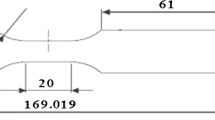Abstract
The fatigue behavior during high cycle fatigue testing and the tensile behavior of 5A06 aluminum alloy considering the anisotropy were studied. Two types of specimens including longitudinal specimen (parallel to the rolling direction) and transverse specimen (perpendicular to the rolling direction) were prepared. Infrared thermography was employed to monitor the temperature evolution during the fatigue and tensile tests. The temperature evolution curves in the two directions were contrastively analyzed. It is found that the temperature evolution during fatigue process possesses four stages: initial temperature rise stage, slow temperature decline stage, rapid temperature rise stage, and finial temperature decline stage. The heat generating mechanisms of the four stages are discussed. Obvious differences can be found between the longitudinal specimen and transverse specimen in fatigue strength and fatigue life. The fatigue strength and fatigue life of longitudinal specimen are higher than those of transverse specimen. During the tensile and fatigue testing process, the fracture temperature in the transverse direction are higher than that in the longitudinal direction. The fatigue strength prediction by means of infrared thermography has a good consistency with that by the traditional method.
Similar content being viewed by others
References
Xu C, Yang SL. Research Progress on Fatigue Behavior of Aluminum Alloy[J]. Journal of Shanghai University of Engineering Science, 2012, 26(2): 105–110
Li BH, Tang ZM, Yan JW, et al. Research on Effects of Welding Ways on Joint Properities of Thick 5A06 aluminum alloy[J]. Aerospace Manufacturing Technology, 2011, 261(1): 34–37
Lubnow TS, Louthan MR. Microscopy, Fractography and Failure Analysis-an Introduction[C]. In: Louthan M R, Place T A. Microscopy, Fractography and Failure Analysis, Proceeedings of a Symposium on Microscopy, Fractography and Failure Analysis, Boston 1986
Kanel GI, Razorenov SV, Bogatch A, et al. Spall Fracture Properties of Aluminum and Magnesium at High Temperature[J]. J. Appl. Phys., 1996, 79(11): 8310–8317
Mukai T, Kawazoe M, Higashi K. Strain Rate Dependence of Mechanical Properties in AA5056 Al-Mg Alloy Processed by Equal Channel Angular Extrusion[J]. Mater. Sci. Eng., A, 1998, 247(1-2): 270–274
Kawazoe M, Shibata T, Mukai T, et al. Elevated Temperature Mechanical Properties of A 5056 Al-Mg Alloy Processed by Equal Channel Angular Extrusion[J]. Scripta Mater., 1997, 36(6): 699–705
Luo ZJ, Guo NC, Gong QY. A Study of the Superplasticity of LF6 Aluminium Alloy[J]. Acta Aeronautica et Astronautica Sinica, 1987, 8(7): 384–391
Long ND. Deformation in LF6[J]. Journal of Aeronautical Materials, 1997, 17(2): 32–39
Zhao HJ, He S, Geng HB. Tensile Properties and Microstructure of LF6 Alloy Welded Joint Subjected to Thermal Cycling[J]. Transactions of the China Welding Institution, 2004, 25(1): 33–39
Zhao YH, Lin LY. Corrosion behaviors of LF6 Al-Mg Alloy with Different Processing and Surface Treatment in Deep Seawater [J]. The Chinese Journal of Nonferrous Metals, 2001, 11(z1): 27–31
Guo JL, Yin ZM, Shang BC, et al. Study on in-plane Anisotropy of 2524 Aluminum Alloy Aheet[J]. Journal of Aeronautical Materials, 2009, 29(1): 1–6
Xiao J, Etienne P, Wang M, et al. The Research of the Anisotropic Fatigue Behavior of 7475Aluminum Alloy Plate[J]. Journal of Shanghai Jiaotong University, 2011, 45(11): 1678–1683
Yan ZF, Zhang HX, Wang WX, et al. Temperature Evolution Mechanism of AZ31B Magnesium Alloy during High-cycle Fatigue Process[J]. Theor. Appl. Fract. Mec., 2014, 70: 30–38
Fan JL, Guo XL, Wu CW. A New Application of the Infrared Thermography for Fatigue Evaluation and Damage Assessment[J]. Int. J. Fatigue, 2012, 44: 1–7
Pastor ML, Balandraud X, Grédiac M, et al. Applying Infrared Thermography to Study the Heating of 2024-T3 Aluminium Specimens under Fatigue Loading[J]. Infrared Phys. Technol., 2008, 51(6): 505–515
Giancane S, Chrysochoos V, Dattoma A, et al. Deformation and Dissipated Energies for High Cycle Fatigue of 2024-T3 Aluminium Alloy[J]. Theor. Appl. Fract. Mec., 2009, 52(2): 117–121
Thomson W. Mathematical and Physical Papers[M]. London: Focal Press, 1990
Cheng ZF. The Insulation Constant and Kelvein Formula in Solid State Thermodynamics[J]. Journal of Southwest China Normal University (Natural Science), 2000, 25(3): 253–256
Rosa GL, Risitano A. Thermographic Methodology for Rapid Determination of the Fatigue Strength of Materials and Mechanical Components[J]. Int. J. Fatigue, 2000, 22(1): 65–73
Luong MP. Fatigue Strength Evaluation of Metals Using an Infrared Thermographic Technique[J]. Mech. Mater., 1998, 28(1-4): 155–163
Wang K, Yan ZF, Wang WX, et al. Temperature Evolution and Fatigue Properties Prediction for High Cycle Fatigue of Magnesium Alloy under Alternate Loading[J]. Materials Engineering, 2014, 0(1): 85–89
Zhang HX, Wu GH, Yan ZF, et al. An Experimental Analysis of Fatigue Behavior of AZ31B Magnesium Alloy Welded Joint Based on Infrared Thermography[J]. Mater. Des., 2014, 55: 785–791
Author information
Authors and Affiliations
Corresponding author
Additional information
Funded by the National Natural Science Foundation of China (Nos. 51175364, 51505322) and Natural Science Foundation of Shanxi Province of China(No. 2013011014-3)
Rights and permissions
About this article
Cite this article
Yan, Z., Zhang, H., Chen, P. et al. Anisotropy of fatigue behavior and tensile behavior of 5A06 aluminum alloy based on infrared thermography. J. Wuhan Univ. Technol.-Mat. Sci. Edit. 32, 155–161 (2017). https://doi.org/10.1007/s11595-017-1574-1
Received:
Accepted:
Published:
Issue Date:
DOI: https://doi.org/10.1007/s11595-017-1574-1



